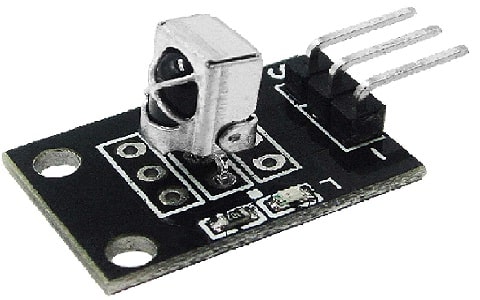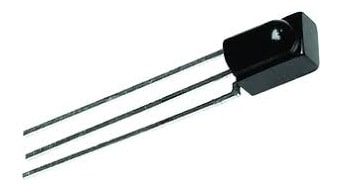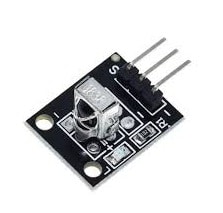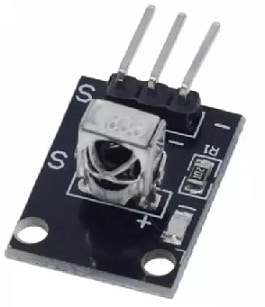In today’s world of remote-controlled systems, IR (Infrared) receiver modules play a vital role in enabling wireless communication between electronic devices. Whether you are building a home automation system, a DIY electronics project, or an industrial sensor network, IR receiver modules help decode signals from standard remote controls. This article compares five of the most popular IR receiver modules: KY-022, TSOP382, HX1838, VS1838B, and TL1838, focusing on their features, specifications, working principles, and best use cases.
What is an IR Receiver Module?
An IR receiver module detects infrared light modulated at specific frequencies (typically 38 kHz) and converts it into digital signals that microcontrollers can read. These modules are widely used in consumer electronics such as TVs, air conditioners, and Arduino-based hobby projects.
KY-022 IR Receiver Module
The KY-022 is a 3-pin IR receiver module designed to interface easily with Arduino and other microcontrollers. It uses the TSOP1838 IR receiver chip and operates at 38 kHz, the standard IR carrier
frequency. Please refer to this link to know more about the KY-022 Module.

KY-022 Module
Features
- Operating Voltage: 2.7V to 5.5V.
- Carrier Frequency: 38 kHz.
- Operating Current: 0.4 – 1.5 mA.
- Reception Distance: Up to 18 meters.
- Built-in LED indicator.
- Dimensions: 24.5mm x 16mm x 7mm.
Pros
- Simple integration with Arduino.
- LED for signal detection feedback.
- Good range and reliability.
Cons
- Limited resistance to ambient light interference.
- Requires direct line-of-sight.
Best Use Case
- Educational projects, DIY home automation, and IR-controlled toys.
TSOP382 IR Receiver Module
The TSOP382 is a compact and high-performance IR receiver from Vishay. Unlike the KY-022, it is a standalone component and not part of a breakout module. This makes it ideal for embedded designs and
custom PCB development.

TSOP382 IR Receiver Module
Features
- Supply Voltage: 2.5V to 5.5V.
- Carrier Frequency: 36 kHz, 38 kHz, or 40 kHz (model-specific).
- Very low power consumption: 0.35 mA.
- Noise filter for ambient light.
- Narrow reception angle for accuracy.
Pros
- High immunity to ambient light.
- Ultra-low power consumption.
- Wide operating voltage.
Cons
- No onboard indicator LED.
- Requires additional components for prototyping.
Best Use Case
- Industrial applications, embedded systems, energy-efficient devices.
HX1838 IR Receiver Module
The HX1838 is a widely available IR module that comes in kits and preassembled with an IR remote. It is based on the VS1838B IR sensor and is plug-and-play with Arduino boards.

HX1838 Module
Features
- Voltage: 2.7V to 5.5V.
- Carrier Frequency: 38 kHz.
- Comes with an IR remote (in kits).
- Includes LED and resistors on PCB.
Pros
- Affordable and beginner-friendly.
- Often bundled with remote controls.
- Pre-wired for immediate use.
Cons
- Quality varies between manufacturers.
- Susceptible to signal interference.
Best Use Case
- Quick prototyping, beginner Arduino projects, and remote control demonstrations.
VS1838B IR Receiver Module
The VS1838B is the raw IR receiver component used in many modules like the HX1838 and KY-022. It
is compact and sensitive to 38 kHz IR light, making it suitable for custom designs.

VS1838B IR Receiver Module
Features
- Operating Voltage: 2.7V to 5.5V.
- Carrier Frequency: 38 kHz.
- High reception sensitivity.
- Low power consumption.
Pros
- Reliable component for integration.
- Consistent performance.
- Easily sourced from electronics suppliers.
Cons
- Requires additional components for a full circuit.
- No onboard LED or breakout pins.
Best Use Case
Custom circuit boards, low-cost production, and IR integration in smart devices.
TL1838 IR Receiver Module
The TL1838 is another 38 kHz IR receiver component that is popular in DIY electronics and is often used in combination with microcontrollers and digital devices.

TL1838
Features
- Voltage: 2.7V to 5.5V.
- Modulation: 38 kHz.
- Power Consumption: Low (< 1.0 mA).
- High immunity against ambient IR.
Pros
- Wide availability.
- Robust performance in typical lighting conditions.
- Easy to implement in basic projects.
Cons
- Similar limitations to VS1838B.
- No built-in LED indicator.
Best Use Case
- IR-controlled robots, home automation, and low-cost electronics.
Comparison Table
The comparison between KY-022, TSOP382, HX1838, VS1838B, and TL1838 IR receiver modules is given below.
|
Feature |
KY-022 | TSOP382 | HX1838 | VS1838B |
TL1838 |
|
Operating Voltage |
2.7V to 5.5V | 2.5V to 5.5V | ~2.7V to 5.5V | 2.7V to 5.5V | ~2.7V to 5.5V |
|
Carrier Frequency |
38 kHz | 36/38/40 kHz | ~38 kHz | 38 kHz |
~38 kHz |
| Power Consumption | 0.4 – 1.5 mA | 0.35 mA |
~1.0 mA |
<1.0 mA |
<1.0 mA |
|
Range |
Up to 18m | 10–15m | 8–12m | 10–15m | 10–12m |
| Built-in LED | Yes | No | Yes |
No |
No |
|
Breakout Module |
Yes | No | Yes | No | No |
| Ambient Light Filter | Moderate | Excellent | Moderate | Good |
Good |
|
Ease of Use |
High | Medium | Very High | Medium | Medium |
Which IR Receiver Should You Choose?
The right IR receiver module depends on your specific application:
- For Beginners & Arduino Projects: The HX1838 or KY-022 are ideal. They are plug-and-play, come with LED indicators, and are easy to wire.
- For Embedded & Industrial Applications: The TSOP382 offers high immunity to ambient light, low power consumption, and compact size – perfect for serious designs.
- For Custom PCBs & Bulk Projects: The VS1838B or TL1838 provides excellent value when building from scratch and offering reliable IR signal decoding.
FAQs
Q1: Can these IR receivers work in bright sunlight?
A: Most modules struggle in direct sunlight. TSOP382 and TL1838 have better ambient light resistance.
Q2: Can I use these modules with a Raspberry Pi?
A: Yes, with proper GPIO pin configurations and libraries.
Q3: Do I need a resistor or transistor with these modules?
A: For raw sensors like VS1838B or TSOP382, yes. Breakout modules like KY-022 already include them.
IR receiver modules are indispensable in wireless control systems. Whether you’re an electronics hobbyist or a hardware developer, understanding the differences between these modules helps in selecting the most efficient, reliable, and cost-effective option for your project. For fast prototyping, go for KY-022 or HX1838. For advanced or custom implementations, consider TSOP382 or VS1838B. Always verify module compatibility with your controller board and test in your target lighting conditions
to ensure the best performance.
Have you tried building a project using one of these IR modules? Let us know your experience in the comments or link to your project!